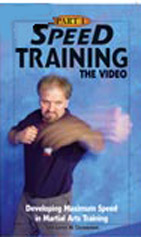Marc MacYoung?
Dianna Gordon MacYoung?
Animal E-list
Crime Avoidance Lectures
Crime Blog
Colorado Classes
Contact Us
FAQs
Hosting A Seminar
Crime Prevention
Expert Witness
Knife Defense
Law Enforcement
Martial Arts
Military
Movie Consulting
Women's Self-Defense
Links
Our Linking Policy
On-line Store
Train with MacYoung
Testimonials
Terms of Use
Topics
of Interest
How hard is it to handle
an attack
that you've dictated when and where
it's going to happen? He isn't ambushing
you ... he's charging into a trap.
MM
Controlling Where He Attacks You
On this page:
He Stops Looking When He Sees The Opening |
But What If He Sees It's a Trap? |
Years ago, Marc ran a state and federally contracted community correctional center. It was a mixed bag facility. A minimum security, pre-release, work release, alternative sentencing and Substance Abuse Revocation Diversion program all rolled into one. That meant embezzlers rubbed elbows with triple murderers, crack addicts shared quarters with security exchange frauds. Some people were locked down, others allowed limited community access (find job, work, medical appointments, etc).
Despite this access, one of the bigger problems were "escapes(1)" by inmates who didn't have community access. Inmates were constantly coming up with ways to sneak out. Every time he found an escape route, Marc shut it down.
The inmates then found another.
Finally using the idea of: Ever notice that when you're looking for something, it's always in the last place you look? he set a trap. He found the escape route they were using and intentionally left it open.
The problem -- for the inmates at least -- was that they jumped down into a razor-wire secured area. And they didn't see the razor wire until they had jumped into the trap. They'd jumped into a cage that they couldn't get out of. There were still escapes, but the drug problem dropped significantly in the facility.
A big reason why drugs went down and escape charges went up was when they were let out of the "cage," the inmates were immediately remanded back to higher custody. They were isolated and within hours marshals and sheriffs came by and took them away. The escapees couldn't get back and tell other inmates it was a trap.
We tell you this story because it conveys a very important trick about human psychology.
Basically once the inmates saw an escape route, they stopped looking for other ways. Unfortunately for them, what they saw, was only the opening Marc wanted them to see. An opening that he had turned into a trap.You can use this same idea to control when and where someone tries to attack you.
He Stops Looking When He
Sees The Opening
Many people feel that the best way not to be attacked is
to make oneself attack proof. The problem with
that idea is you aren't the one who decides
whether or not you are attack proof, he is.
And generally speaking his fist crashing into your face means that he didn't think so.
What's more, that attack landing tells you that there was an opening that you didn't know you had. And how do you protect something that you didn't know you needed to defend (or thought was already defended?)
On the other hand, an awareness of attack range blended with leaving an intentional opening really has a wonderful influence on knowing when the attack is starting and where it is headed.
Insert ready stance photo
Often when people ask Marc about his 'fighting' stance he replies "I'm in it." They wonder how this can be since he's standing there, not only looking relaxed and calm, but obviously so wide open. What they don't understand is that he is waiting for them to move into attack range. Add to that he is watching for them to try to attack through the opening he's left. (Obviously since his groin is protected, as are his sides and the chest is not a good target for impact attacks, the best target for the attacker to go after is his head and neck.
Depending on the nature of attack and the defender's training there are many potential responses
tap shave
spear
beachball
Elbow
shoot and tackle
tap/shave/kick
karate block/karate punch
Any of these will work to stop an attack ...
1) if you practice them.
2) if you remember to move
3) if you move your hands in a sweeping/shielding
manner that covers your entire body and
4) if you've acquainted yourself with
attack range.
5) if you start the move when he initiates the
attack range instead of waiting until you see the fist
looming.
It is extremely rare that someone will attack elsewhere once he sees what he thinks is the best attack option. Once he sees that he's going to stop looking for others. What he doesn't know is that it's a trap. And that's another psychological advantage you have: He thinks he has gotten over on you! Your counter offensive crashing into him is going to be a total shock to him.
While the decision whether or not to attack is still, ultimately, his, you control when and where he attacks. And how difficult is it to foil an attack when you have controlled when, where and how it happens?
But What If He Sees
It's A Trap?
Before we get to that, let's assume that the guy decides to attack
you through the trap. Those are the dumb ones. At least the ones
dumb enough to attack an officer AND through what turned out to be a
trap. Which face it, not everyone you deal with is Mr. (or Miss) SAT
High Score Holder.
We often say: Ninety percent of all situations can be de-escalated. That does, however, mean that there are still those 10 percent that are going to go sideways no matter what you do.
Plan for it. Better yet, control how it happens. When channeled down into a trap even a ferocious assault ends quickly -- thereby robbing him of his secondary victory. He thinks he's going to win and WHAM! Next thing he knows he's on the deck. That's another tactical advantage of controlling where someone attacks you ... it's easier to put them down.
But what about the smart ones?
Well, put on your dancing shoes because you're going to be cutting a rug tonight after you hear this. Odds are you won't be fighting at all -- which is why you'll have energy to go out dancing.
The really smart ones, will see the trap and slam on the brakes. It's the old kids' patter of "you know/I know." You-know-that-he-knows -that-you -know-that-he-knows-it's-a -trap.
It sounds silly, but that's exactly what it is. And as goofy as that may sound, it's an important part of de-escalation. He's facing jumping into a snake pit, and you both know it.
As such, 99 times out of a 100, it just isn't worth it for him to push it -- especially through physical means. And it will often resolve itself -- as so many shadow dances do -- with you both smiling at each other because officially "nothing is happening."
The "smarter, but not smart enough" types will see the trap, recognize it for what it is, and then proceed to look for another route. These are the ones that will give you the most problems. Except for one thing: You can now explain this whole process in the context of jeopardy. That means you can more easily explain the need for a preemptive action and your reasoning for the level of force you used.

1) Different programs gave prisoners different status. Parole violators were locked down. The usual reason for going over the fence were drug or alcohol runs -- both to get high and to smuggle them back into the facility for other inmates. While jumping the fence for a few hours might not seem like a real prison break out. They were prosecuted as escapes as well as drug or alcohol offenses. Rolling up inmates was a common occurrence. Return to Text


Indonesian Fighting Fundamentals
Learn More>
Order Now!

The Missing Link: Self-Protection Through Awareness,
Avoidance and De-Escalation
Learn More >
Order Now!

Surviving a Street Knife Attack
Learn More >
Order Now!

Escape Combatives
Special Bonus Feature
ESCAPE DRIVING
Learn More >
Order Now!

Fighting Arts of Indonesia
Learn More >
Order Now!

Filipino Kuntao
Learn More >
Order Now!

Speed Training
Learn More >
Order Now!

Speed Training: The
DVD
Learn More >
Order Now!

Combat Sanshou: Striking
Learn More >
Order Now!

Fighting Footwork of Kuntao/Silat Volume 1
Learn More >
Order Now!
| About navigating this site | Animal List | Bibliography | Bullies | Burglary while on vacation | Classes in Colorado | Car Jacking | Children and Martial Arts | Child Safety | Criminal Mindset | Cults in MA/SD | De-Escalation | E-mail Dianna | E-mail Marc| FAQs | Have MacYoung speak about crime avoidance | Home Page | Home Defense | Hosting a Seminar | Fear | Five Stages of Crime | Knife Fighting | Legal Issues | LEO/Correctional Officer/EMS | Linking policy | Links | Martial Arts | Photo Gallery | Property Crime | Psychology | Rape | Robbery | Safe Dating | Self-Defense Training | Selling your books/DVDs on NNSD | Seminar Schedule | Stalking/Domestic Violence | Street Fighting | Terms of Use | Testimonials | Train with Marc MacYoung | Who is Dianna Gordon MacYoung? | Who is Marc "Animal" MacYoung? | Victimhood | Workplace Problems | Zero Tolerance | ||
| © 1998-2008 No Nonsense Self-Defense, LLC. All rights reserved. |